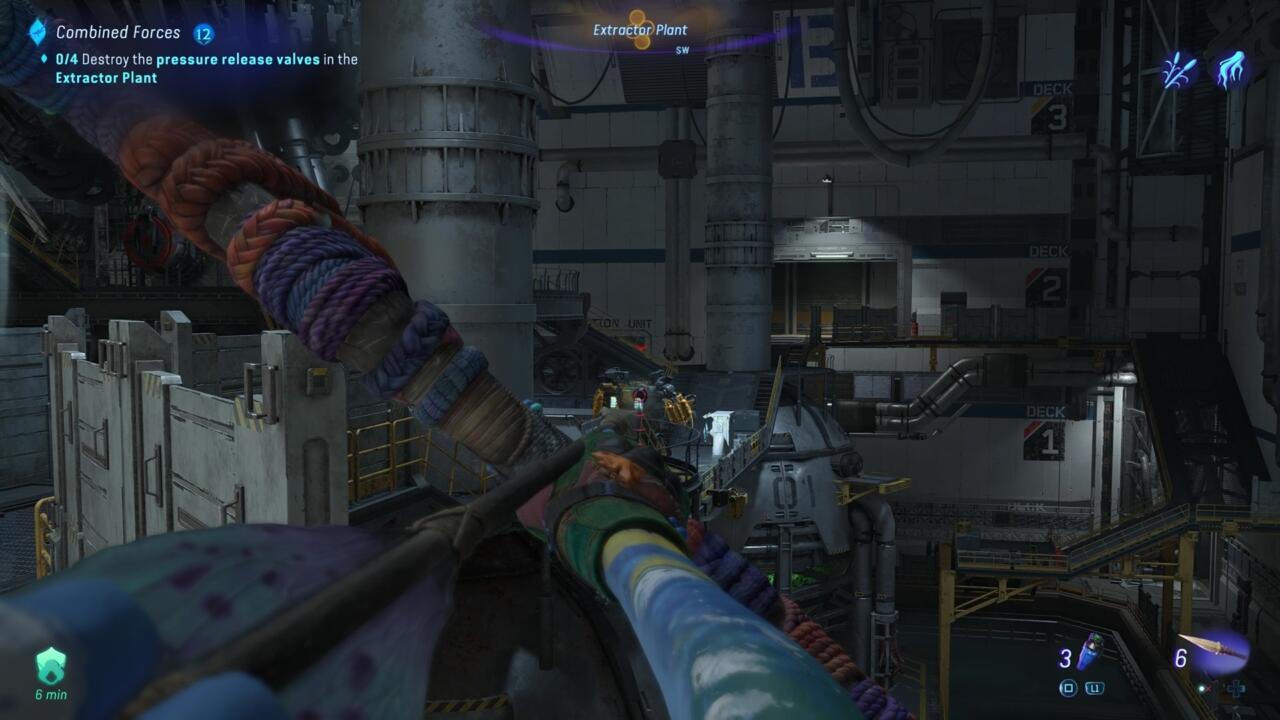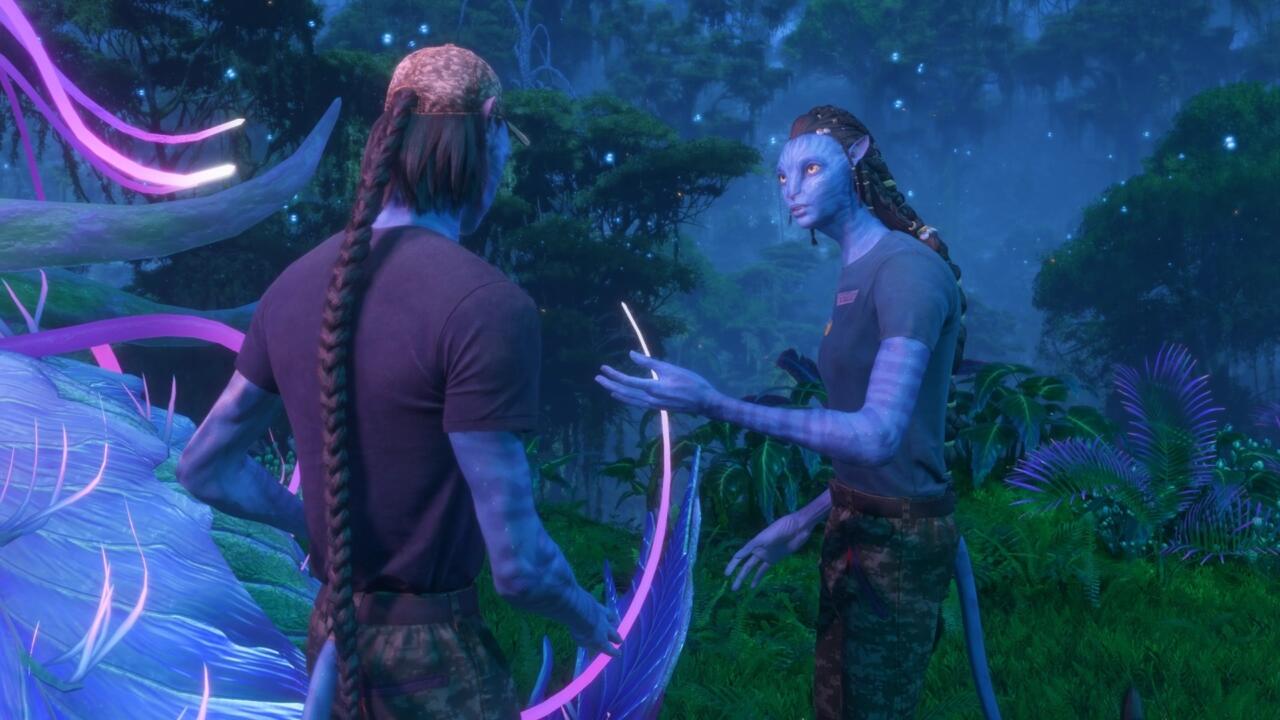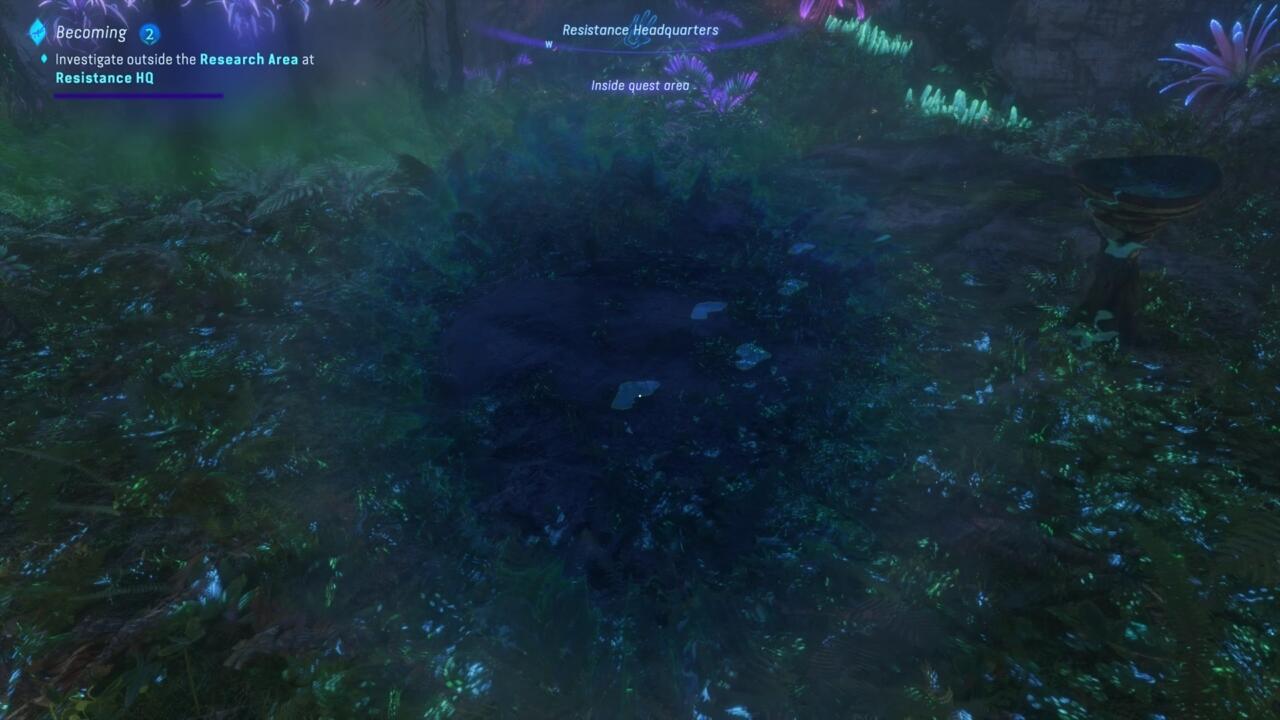Before starting Avatar: Frontiers of Pandora, I was reminded of what I think of when considering any open-world game: Killscreen’s review of Fallout 4 by Chris Breault, and the opening line, “Here comes the trashman!” Breault discusses an experience of constantly picking up and covering yourself in the garbage scattered around that game’s massive world. It’s a description that feels highly applicable to most open-world games–huge, but full of refuse that you spend endless hours picking through and carting around, only to replace it with newer, better garbage. Most open-world games are too concerned with filling their worlds, both literally and metaphorically, with a deluge of needless stuff, and it’s why I find the genre can be off-putting.
It’s the fear of that torrent of trash that made Avatar: Frontiers of Pandora surprisingly refreshing and also endearing. Frontiers pushes aside some of the concerns about sifting through heaps of junk and clearing incessant icons from your HUD by keeping your screen clear so you can appreciate its gorgeous vistas and strange creatures, thus encouraging you to take in and understand the world around you. Though it still has a lot of open-world staples, like numerous activities and an expansive crafting system, it manages to incorporate them as systems that enhance an overarching feeling of exploration and discovery, and it never bombards you with them. These elements feel like they’re meant to help you experience the world itself, instead of just filling it up with more litter.
Two things make Frontiers of Pandora work: its incredible setting and its alien protagonist. I’ve never had much more than a passing interest in the Avatar films, but Pandora, the lush alien world on which they take place, is an outstanding location to set a video game. It’s an enormous and strange place, filled with alien plants, creatures that glow in darkness, and wildlife that towers over the landscape.
The setting empowers developers at Massive Entertainment with the freedom to use or imagine landscapes that are always fascinating to explore. The scale of elements like colorful forests or enormous mountains that float in the air is often arresting, and the alien flora that might spit out spores that make you run faster or reach out with electrified tentacles if you get too close make these more than fields you sprint through to get to wherever you’re headed next. You really feel like you’re discovering Pandora as you work through the game, and its unfamiliar nature helps keep this process engaging. That’s amplified even more by the fact that Frontiers of Pandora is absolutely beautiful, with art direction that further enhances its landscapes with impossible rock formations and bright neon colors, bringing a distinct vibrancy to its lush world.
These environments are greatly served by the fact that you play as a Na’vi, one of the 10-foot-tall blue alien people who populate Pandora. Your size and physical prowess give you a natural speed and strength, allowing you to sprint over and climb things with relative ease. Pandora is sprinkled with huge mushrooms, massive snaking roots, and retracting vines that give you a wealth of traversal options for reaching its many heights. The world is not only stunning, but a blast to run around in, and your parkour-like abilities let you turn forests, mountains, and enemy bases into playgrounds to leap around.
Frontiers of Pandora takes place in the same timeline as the movie’s story but is set on another continent, and it uses that independence to go in some interesting directions. The RDA, a massive Earth corporation, has invaded Pandora in hopes of exploiting and colonizing it. You play as a Na’vi who was raised by humans but escapes with RDA defectors to create a resistance movement, putting you on the familiar, Far Cry-like path of seeking out and working with other Na’vi clans to build a coalition against the invaders. It’s a premise that works well to give your protagonist a nascent connection to Pandora that you develop over time, putting you in a position to learn about the world while the story explores ideas of identity, belonging, and colonialism.

Gallery
Throughout Frontiers, you’re fighting the technologically superior humans who use mech suits, assault rifles, and VTOLs, while destroying their massive, polluting industrialized facilities. Those familiar with Ubisoft’s long-running Far Cry series will recognize the overall vibe of Avatar’s approach to combat, but Massive has found smart ways to iterate on the Ubisoft open-world formula to better serve the Avatar setting. Combat encounters are almost always a mix of straight fighting with a variety of weapons and using stealth to gain an advantage over your opponents. Where Frontiers steps away from tried-and-true Ubisoft ideas is in the mismatch between human enemies and your Na’vi protagonist.
The RDA outclasses you in terms of weapons and numbers, and you can’t really stand your ground against them–assault rifles tear through Na’vi just as easily as they do humans. Instead, you have to rely on quick movement and quicker thinking for success in combat. Your Na’vi abilities let you dash around the battlefield to find cover or climb above enemies, allowing you to quickly reposition yourself to nail a mech suit’s vulnerable heat vents or snipe an explosive tank near a band of soldiers.
The hit-and-run aspect of combat is further amplified by the fact that everything is built for six-foot-tall humans, but you’re a 10-foot-tall alien. Running around enemy bases, sliding through low doorways, and leaping onto high catwalks gives every battle a fast-paced novelty that has you constantly assessing your surroundings for a new spot to regroup or give yourself an edge. You’re too big for most places, which carries advantages and disadvantages, and changes how you might otherwise think about these spaces.
This approach to combat makes classic Ubisoft open-world elements like assaulting a slew of enemy bases feel fun and fresh because, while the spaces are familiar, they’re much more open and inviting thanks to your means of traversing them. Massive also shakes up the formula familiar to Far Cry fans with requirements that go well beyond the usual “kill every enemy in a base in order to take it over” objectives. Instead, your goal is to destroy the RDA’s machinery, often by flipping switches, sabotaging generators, hacking computers, and blowing up cooling vents. Doing these things without setting off any RDA alarms earns you better rewards, encouraging thoughtful and often stealthy approaches that further push you to understand the environment and find novel uses for it.

Gallery
Combat is generally fast and exciting, but it’s at its best in large areas with a lot of variety to the geography. Enclosed spaces like the interiors of RDA bases, which you’ll find yourself in throughout the story campaign, are more hit-and-miss depending on their design. The RDA tends to be highly threatening, dumping ammo on you from lots of directions seemingly with no requirement to reload, and while your health regenerates over time and you can heal yourself instantly with a limited number of health packs, you still get shredded by guns. If a space is too small or doesn’t provide many opportunities to reposition for safety, it starts to feel oppressive and irritating. This is coupled with the fact that your weapons fire slowly, as in the case of bows, or have fairly small magazines, like the assault rifle, so you’re never in a position to straight-up overpower a foe. In areas that cut your movement capabilities, you’re the fish in the barrel.
Most of the time, though, you feel like a guerrilla-fighting savant as you do things like sneak up, hack a mech, short it out, and then yank out its driver. Success in combat also relies on using the right weapon for the job of blowing up weak points or hitting a target at a certain range, and Frontiers of Pandora generally rewards you for thinking critically and acting decisively in engagements. Along with its fast and fluid movement and improvisational nature, you get the sense of being a highly effective fighter, without necessarily being overpowered and unstoppable.
Frontiers’ story is interesting as it ramps up the battle with the RDA, especially in its later hours as the stakes rise. But it also often has the open-world problem of spreading you a little too thin, making it tough to remember the names of characters and what their deal is, especially a few hours after initial contact. Some folks are relegated to side quests that you might not have played, giving them a disposable quality to their character. On a couple of occasions, potentially emotional moments where my character was worried or upset about someone left me asking, “Wait, who?”
That said, the main story has some very well-crafted moments. Climbing the ikran rookery, where you get one of Avatar’s flying dinosaur creatures to ride for the rest of the game, is a testament to the game’s excellent movement systems. It’s a lengthy platforming segment that leads you high into the floating mountains and rewards you with something memorable. A few missions send you into huge RDA bases to sneak and sabotage in a way that would be right at home in dedicated stealth-action games. Frontiers of Pandora often is just as adept at impressive and over-the-top cinematic story moments as it is with its ambient open-world systems.

When you’re not fighting the RDA, you’re engaging more directly with Pandora, and the game keeps things compelling by pushing you to consider the world around you, rather than dumping a mess of map markers and HUD waypoints to guide you. You’re sent to mission objectives and crafting materials by written directions that reference your compass, landmarks, and place names, which helps make the world feel more like a place you’re a part of, rather than a landscape you’re just passing over.
Na’vi vision, an ability that highlights certain things in the environment, is key to discoveries. You’ll use it all the time–it shows you enemies through walls, picks out which plants you can forage from, and brings up a single, mission-specific waypoint that helps you get where you’re going without constantly pulling up your map. It’s an inclusion that has its ups and downs: On one hand, it moves you closer to the idea of feeling like a Na’vi, helping you function as a hunter and gatherer on Pandora, and provides a combat advantage fights would probably be too difficult and annoying without. On the other hand, you’ll activate Na’vi vision almost constantly to do just about everything, which makes it feel like a crutch that undercuts the otherwise quite minimalistic approach to the UI.
The Na’vi vision and directions systems pair well with Frontiers of Pandora’s big emphasis on crafting, which is how you improve your character to take on tougher creatures, enemies, and story missions. Despite crafting being a big part of the game, it relies a lot less on the junk collection and annoying busywork that is common in open-world games. You’ll craft a lot of gear using recipes unlocked from vendors in different Na’vi and human settlements, but you don’t have to hunt and skin 10 boars just to make a new wallet. Instead, each new weapon or piece of armor only requires two items, such as a plant root and a predator tooth, to make. The quality of the item–how much damage it does or how much health it grants you–is determined by the quality of the ingredients you use.
This approach keeps crafting from being a slog while still incentivizing you to forage and hunt for better items, which is itself in keeping with the overall idea of learning to live and survive on Pandora. The game provides you with the information for where better materials can be found but expects you to track them down yourself. You can craft the same piece of armor over and over again with different materials, so you’re fully capable of enhancing your gear at almost any point. Picking plants or peeling bark from a tree without damaging it also requires you to find the right angle from which to pull, and with a controller, that means gauging the rumble of your controller while you move the analog stick around to find the sweet spot. It’s a small minigame but helps make the act of gathering material more active and interesting.

Not every attempt to emphasize exploration and figuring things out yourself works, though. Story missions and side quests will often send you to investigate a location in hopes of finding a missing person or uncovering what the RDA was up to. Your vision highlights things in the environment like footprints and discarded objects, and you have to scan each clue for information and then select two related clues in succession so your character can draw some conclusions.
It’s a system that rarely feels intuitive; the clues almost always all seem related, or it can be tough to guess exactly which two the developers want you to pick, usually leading to an unsatisfying trial-and-error process. Investigations are never complicated, so it’s simple enough to brute-force them when you’re not getting it, but that just undercuts the idea of using your skills to figure things out even more. Sometimes, clues are small or found somewhere that’s not obvious, so you’ll wander around for five minutes, staring at the ground, wondering what you’re missing. And these investigations almost always come to the same conclusion of providing you with a trail to follow using your Na’vi vision. Investigations are a fun idea that are meant to make you feel like a skilled tracker, but they never quite pay off in a satisfying way.
Still, most of Avatar: Frontiers of Pandora’s work to emphasize its open world is very effective. Pandora is often magnificent, and I stopped repeatedly just to look around and take it in. Diverting from a goal to gather up some armor bark and bow string or blow up an industrial facility were fun detours and felt like an important part of existence there. Best of all, I never felt like an open-world trashman, dumping junk on the way to the next map marker. Instead, Avatar: Frontiers of Pandora made me feel like I was adventuring in a place worth exploring, and I’m eager to go back.
























